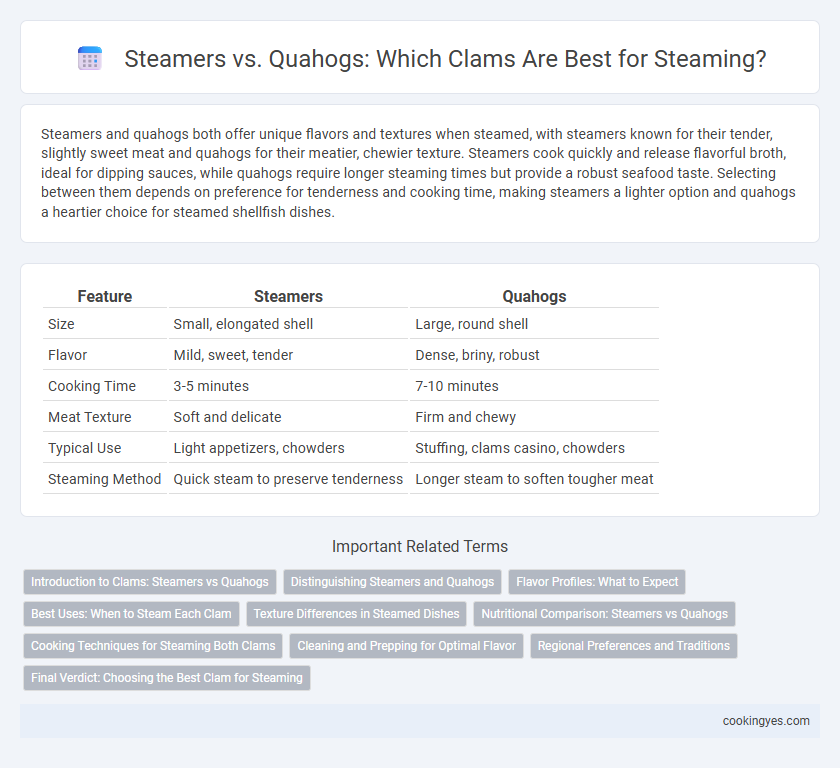Steamers and quahogs both offer unique flavors and textures when steamed, with steamers known for their tender, slightly sweet meat and quahogs for their meatier, chewier texture. Steamers cook quickly and release flavorful broth, ideal for dipping sauces, while quahogs require longer steaming times but provide a robust seafood taste. Selecting between them depends on preference for tenderness and cooking time, making steamers a lighter option and quahogs a heartier choice for steamed shellfish dishes.
Table of Comparison
| Feature | Steamers | Quahogs |
|---|---|---|
| Size | Small, elongated shell | Large, round shell |
| Flavor | Mild, sweet, tender | Dense, briny, robust |
| Cooking Time | 3-5 minutes | 7-10 minutes |
| Meat Texture | Soft and delicate | Firm and chewy |
| Typical Use | Light appetizers, chowders | Stuffing, clams casino, chowders |
| Steaming Method | Quick steam to preserve tenderness | Longer steam to soften tougher meat |
Introduction to Clams: Steamers vs Quahogs
Steamers and quahogs are two popular types of clams, each distinct in size, texture, and flavor, influencing their steaming methods. Steamers, smaller and more tender, cook quickly and release a sweet, briny broth ideal for steaming. Quahogs, larger and firmer with a robust flavor, require longer steaming times to tenderize, making them a hearty choice for clam dishes.
Distinguishing Steamers and Quahogs
Steamers, also known as soft-shell clams, have a thinner, more fragile shell with a sweet, briny flavor and a chewy texture, making them ideal for steaming quickly to preserve tenderness. Quahogs, or hard clams, possess a thicker, tougher shell and a denser, meatier texture, often requiring longer cooking times to tenderize while delivering a more robust, oceanic taste. The primary distinction lies in shell hardness and cooking duration, with steamers favored for their delicate meat and quahogs prized for their hearty flavor and versatility in recipes.
Flavor Profiles: What to Expect
Steamers offer a sweet, briny flavor with a tender texture, making them ideal for mild, buttery seasonings. Quahogs have a stronger, more robust taste and a chewier bite, often preferred in dishes needing a bold clam presence. Expect steamers to deliver delicate oceanic notes, while quahogs bring intensity and depth to steamed clam recipes.
Best Uses: When to Steam Each Clam
Steamers excel in quick, high-heat steaming, making them ideal for recipes requiring tender, juicy clams ready in minutes, such as clam boils or pasta dishes. Quahogs, being tougher and meatier, benefit from longer, gentler steaming suited for chowders or stuffing where firm texture is prized. Choosing steamers for fast meals and quahogs for hearty preparations ensures optimal flavor and texture in clam dishes.
Texture Differences in Steamed Dishes
Steamers exhibit a tender, slightly chewy texture when steamed, offering a delicate bite that enhances soups and chowders. Quahogs, being larger and tougher, become firmer and more robust in texture after steaming, making them ideal for dishes requiring a meatier consistency. The distinct textural differences influence their culinary applications, with steamers preferred for softness and quahogs for a heartier chew.
Nutritional Comparison: Steamers vs Quahogs
Steamers contain lower calories and fat but offer higher iron and vitamin C levels compared to quahogs, making them a nutrient-rich option for boosting immunity. Quahogs provide significantly more protein and omega-3 fatty acids, essential for muscle repair and heart health. Both shellfish types supply valuable minerals like zinc and magnesium, supporting metabolic functions and bone strength.
Cooking Techniques for Steaming Both Clams
Steaming clams such as Steamers and Quahogs requires precise temperature control to avoid overcooking and preserve their natural juices. Steamers typically cook faster, around 5-7 minutes, due to their thinner shells and smaller size, while Quahogs need 10-15 minutes of steaming because of their thicker shells and larger meat. Using a flavorful steaming liquid like broth or beer enhances the taste, and ensuring clams are alive and properly scrubbed beforehand improves the final texture and safety.
Cleaning and Prepping for Optimal Flavor
For optimal flavor, thorough cleaning is essential when preparing both steamers and quahogs. Steamers require scrubbing the shells and soaking in salt water to purge sand and grit, while quahogs need a strong rinse under cold water and removal of the tough outer skin. Proper cleaning ensures a pure, briny taste and avoids gritty textures in the finished dish.
Regional Preferences and Traditions
Steamers are predominantly preferred in New England, where their tender, slightly sweet meat reflects regional coastal flavors and is traditionally steamed with garlic and broth. Quahogs, larger and tougher, are favored in Mid-Atlantic areas and often used in hearty clam chowders or stuffed clam recipes, aligning with local culinary customs. These regional preferences highlight distinct cultural traditions, with steamers symbolizing casual beachside dining and quahogs representing more robust, rustic fare.
Final Verdict: Choosing the Best Clam for Steaming
Steamers and quahogs offer distinct textures and flavors ideal for steaming; steamers provide a tender, sweet bite while quahogs deliver a chewier, heartier experience. For optimal steaming results, steamers are preferred due to their delicate meat and quicker cooking time, preserving sweetness and freshness. Choosing the best clam depends on desired texture preference and cooking speed, with steamers often deemed superior for classic steamed clam dishes.
Steamers vs Quahogs for steaming Infographic

 cookingyes.com
cookingyes.com